Article contents
Diagnostic Imaging in Disasters: A Bibliometric Analysis
Published online by Cambridge University Press: 01 August 2017
Abstract
To investigate the role of diagnostic imaging in the clinical diagnosis, treatment, and follow-up management of patients in response to disasters.
A MEDLINE (OVID) search of original research articles identified 177 articles on this topic published since 2000. A bibliometric analysis was conducted on the top 100 articles ranked by average yearly citation.
The most frequently studied disaster categories were disease outbreak (55 articles), armed conflict (23 articles), terrorist incident (10 articles), and earthquake (7 articles). The most studied disasters were the H1N1 influenza outbreak in 2009 (28 articles), Severe Acute Respiratory Syndrome outbreak in 2003 (24 articles), War in Afghanistan, 2001-2014 (8 articles), Iraq War, 2003-2011 (6 articles), and the Sichuan earthquake (China) in 2008 (6 articles). Among the first authors, 59 were primarily affiliated with Radiology. The United States of America produced the most articles (25 articles), followed by the People’s Republic of China (24 articles). Eighty-one studies were retrospective, with 19 studies being prospective. Computed tomography was the most investigated modality (52.8%), followed by conventional radiography (33.3%) and ultrasound (9.7%).
Our study identifies intellectual milestones in the utility of diagnostic imaging in response to various disasters, and could help guide future research in developing disaster management plans. (Disaster Med Public Health Preparedness. 2018;12:265–277)
- Type
- Systematic Review
- Information
- Copyright
- Copyright © Society for Disaster Medicine and Public Health, Inc. 2017
References
- 9
- Cited by


